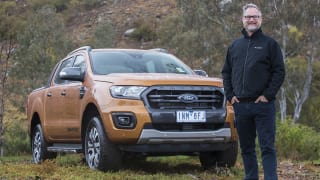
Ford Ranger 2019 review
Does Ford dare mess with its winning Ranger formula, or should it push the boat out to try and claim a technological edge?
Browse over 9,000 car reviews
There's a lot more to the updated 2019 Mitsubishi Triton ute than just a new look.
The brand has added safety features, improved the comfort and convenience levels across the board, and made more changes than meet the eye.
The bad news? Prices are up on most models - and the increases are greatest on the models people buy most: dual cab 4x4 models. Fuel use has gone up, too.
So, can the updated Triton justify its higher asking price in the tough-fought ute segment dominated by its main rivals, the Toyota HiLux and Ford Ranger? We'll get to that, but let's take a look at the redesign in a bit more detail.
| Mitsubishi Triton 2019: GLX | |
|---|---|
| Safety rating | |
| Engine Type | 2.4L |
| Fuel Type | Regular Unleaded Petrol |
| Fuel Efficiency | 10.9L/100km |
| Seating | 2 seats |
| Price from | $21,230 |
I'm not the only one who thinks this facelift has been the best yet from Mitsubishi.
The aggressive 'dynamic shield' front end has translated well here, with slimmer headlights, a big chunky bumper and still good clearance for off-roading - watch the video til the end, if that's of interest to you. The side steps have been redesigned for better clearance and tread size, too.
The rear has been redesigned and there are less of the rounded edges that have defined the Triton up 'til now. The tail-lights are squared off and larger, and the guards have been pumped out, negating the need for over-fender extensions - but we're sure the aftermarket will offer up some guard flares soon enough, or maybe even a body kit.
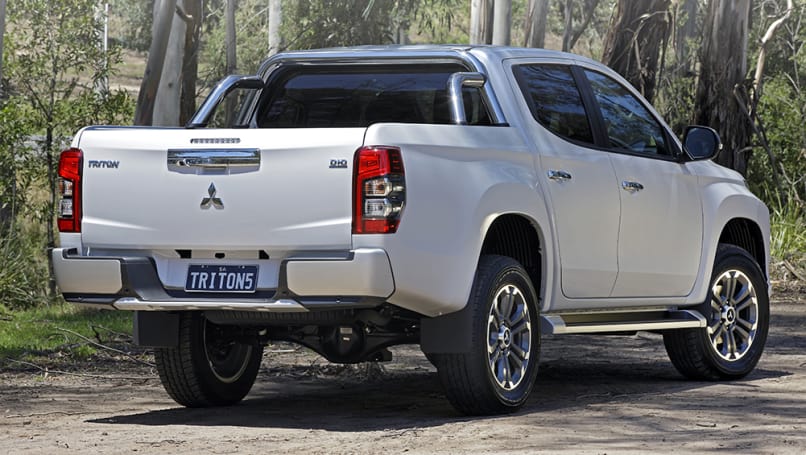
There is a rear step bumper, and top models now get a tub liner. You can still option a hardtop tonneau cover if you need. There is reasonable underbody protection, but Mitsubishi isn't planning on doing a hardcore version like the Toyota HiLux Rugged X (and no luxury pack for that matter, either).
In terms of exterior size, its dimensions are bigger in most directions. The length of the dual cab pick-up is now 5305mm (up 25mm) on a 3000mm wheelbase (unchanged), while the height is up by 15mm to 1795mm. Width is unchanged at 1815mm. The ground clearance has likewise risen by 15mm to 220mm.
Check out the interior images for the design changes to the cabin, including the new padded areas, leather steering wheel, leather gear knob and new more luxurious handbrake handle... it's the little things, after all.
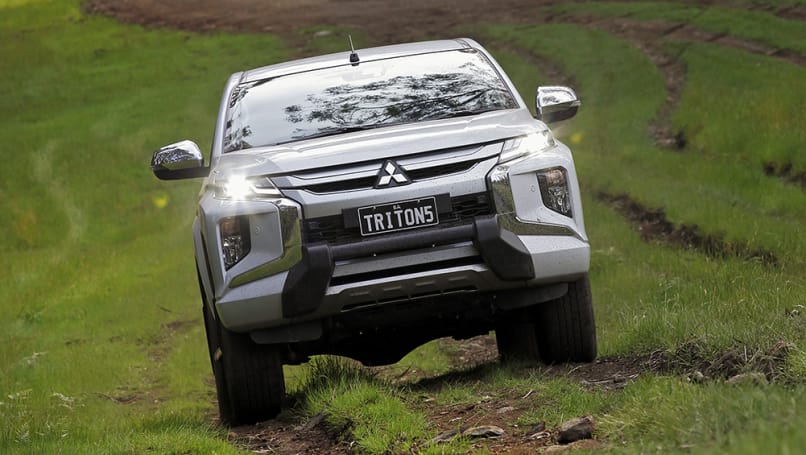
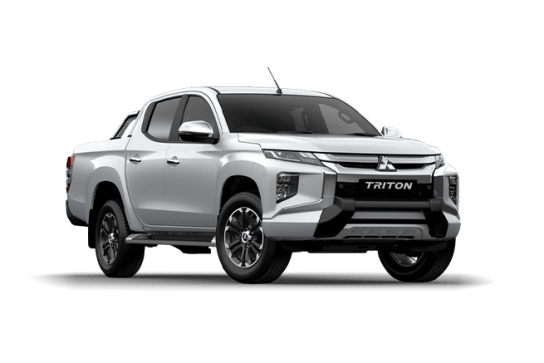
The changes haven't been huge in the cabin, but there are some worthwhile improvements.
Things like new padded sections on the centre console lid, door trims, at the edges of the transmission tunnel (to stop you bashing your knees) and a pair of new B-pillar-mounted grab handles for dual cab models make for a more likeable atmosphere.
And while Mitsubishi hasn't added rear air vents, the company has taken an inventive approach by adding what it calls an air circulator, which essentially sucks cold air from the front and uses a Dyson-like fan to blow it to the rear-seat occupants. It works even better than console vents.
The higher-grade models get an updated 7.0-inch touchscreen media system with Apple CarPlay and Android Auto, plus there's Bluetooth phone and audio streaming, DAB radio and GPS location - but not sat nav, which is a bit of a bugger.

Lower grade models get a smaller screen without the extended smartphone tech. But there are two USB ports - one to connect, and one to charge. There's a pair of USB ports for rear seat passengers in high-spec dual cabs, too.
As with the Pajero Sport there's a bit of a lack of loose item storage - but unlike the previous model, you won't have to rely solely on the cup holders between the seats for loose items, as there's a new shelf in front of the gear shifter. Bigger items could be slotted into the bottle holders in the doors.
The interior looks and feels up to the task, if not setting any new standards for the segment.
As for the tub area, what you gets depends on if you choose the cab chassis (available in single, space and dual cab) with tray (flat, box, aluminium or steel tray). These are a bit easier if you want to fit ladder racks/roof racks, or a bespoke tool box setup with drawers and rails.

Of course there's also the pick-up body style, which comes in extra cab or double cab body styles only. It's more suitable if you want to fit a canopy or hard tonneau cover.
For those who need to know, the internal tub dimensions for pick-up models are: 1850mm long for extra cab or 1520mm long for dual cab, 1470mm wide (1085mm between arches - too narrow for a pallet), and 475mm deep.
Payload capacity ranges from 1284kg in the best case scenario (single cab petrol manual 2WD GLX cab chassis) to a low of 858kg (GLS Premium dual cab pick-up 4x4 auto).
There are four models in the range, and how much you can spend will determine what equipment you will get.
The price list opens with the entry-level GLX, then there's the GLX+, then the GLS and GLS Premium. If you want to see what the GLX has vs the GLX+, here's a sort-of comparison.
At the bottom of the cost scale is the GLX, which comes as a single cab model starting at $22,490 plus on-road costs (currently listed at $24,990 drive away price) in 4x2 GLX petrol guise with a five-speed manual gearbox, up to $39,990 for the 4x4 GLX diesel auto.
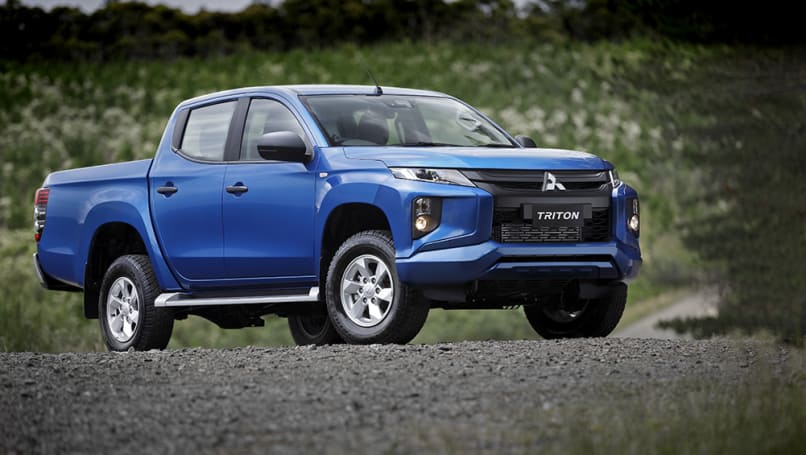
Now, the GLX model - depending on the drivetrain and body style - also comes with an additional alphabetical suffix, ADAS (Advanced Driver Assist System). Check out our detailed pricing and specs story for all the info.
Standard on GLX is a trip computer, cruise control, power steering, air conditioner, halogen headlights (not projector headlights) and daytime running lights, a 6.1-inch touch screen media system with Bluetooth phone and audio streaming (two speakers for the sound system in the single cab, four in the extra cab, and between four and six in the dual cabs - no model gets a subwoofer), AM/FM radio and USB connectivity. GLX and GLX ADAS models roll on 16-inch steel wheels.
GLX+ models push things up a touch in price, with two versions on sale: the $40,490 diesel 4x4 'Club Cab' auto pick-up, and the dual cab diesel 4x4 available in manual ($39,990) or auto ($42,490).
The GLX+ steps up to a 7.0-inch touch screen media system with Android Auto and Apple CarPlay, and while they have GPS location services, none have an in-built navigation system. These models score two USBs up front, and in the GLS and GLS Premium there are dual USBs in the rear as well. No model comes with a DVD player or a sunroof.
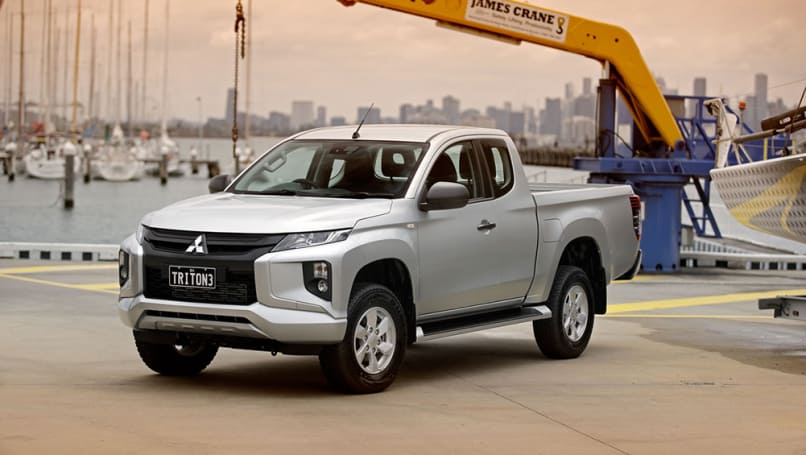
GLX+ models have 16-inch alloy wheels, side steps, a black door sash, chrome interior door handles and climate control air-con.
Next up the rank is the GLS, available as a double cab pick-up only. This version has a list price of $44,490 for the manual and $46,990 for the auto, which is a bump of two grand over the previous model (but there are already deals being done...).
GLS adds Mitsubishi's Super Select II 4WD system with new drive modes, a centre diff lock, a sports bar, 18-inch alloy wheels, a chrome grille, chrome exterior handles and a chrome sports bar, HID headlights, LED DRLs, fog lights, privacy glass, a leather steering wheel and shift knob, fabric door trim inserts, six speakers for the sound system, power folding door mirrors and carpet flooring.
The GLS Premium is a dual cab auto 4x4, and it costs $51,990 on the official list price (but it's $50,990 drive away at the time of writing).

GLS Premium models add a standard fit rear diff lock, a nudge bar, leather-look door trim inserts, push-button start, leather seats, heated front seats, electric driver's seat adjustment, paddle shifters and a tub-liner (under rail). Plus there's a surround-view camera system - see the safety section below for all the details.
If you want to see what other driveaway deals are happening, be sure to search Autotrader for listings.
Colours available for the Triton include three new hues: White Diamond and Graphite Grey, plus the inventively named Red. There's also White, Black, Sterling Silver and Impulse Blue. This generation has no brown or green option.
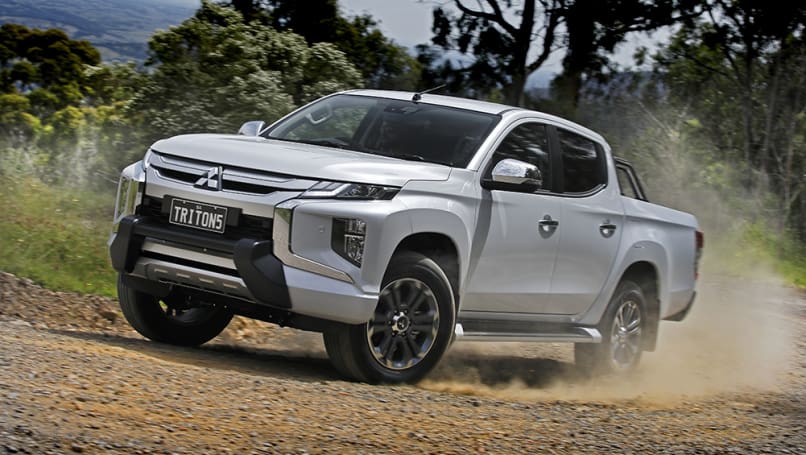
Mitsubishi is offering a range of accessories, as you'd expect. The bullbar and nudge bar both have integrated bash plates, though they aren't as hardcore as a Toyota HiLux Rugged X (and nor do the Triton bars have those excellent rated recovery points). There are optional alloy rims, floor mats, a snorkel, canopy, bonnet protector, roof bars so you can fit an awning, and Mitsubishi also offers an LED light bar (more effective than spotlights for night driving).
There's no sports edition (to rival the Ranger Wildtrak) at launch, but something may be in the pipeline...
The engine specs are unchanged - and so are our ratings for the powertrain.
Under the bonnet is a 2.4-litre turbo-diesel four-cylinder engine producing 133kW of power (at 3500rpm) and 430Nm of torque (at 2500rpm). There's the choice of a six-speed manual transmission or a new six-speed automatic (up from the existing five speed auto), and that's whether you choose the 4x2 or 4x4 model. All oil-burners have a diesel particulate filter, but none use AdBlue.
The petrol engine also goes unchanged in terms of horsepower and engine size - that 2.4-litre four-cylinder motor doesn't have a turbo charger, and it produces 94kW (at 5250rpm) and 194Nm (at 4000rpm). There's a five-speed manual gearbox, and it's rear-wheel drive only.
Towing capacity remains at 750kg for an unbraked trailer and 3100kg for a braked trailer for diesel models. Petrols can tow 750kg/1800kg. No Triton comes with a towbar standard, and none at the launch were, either - but you can watch our ute comparison to see how the Triton towed compared to the Ranger and HiLux.

Kerb weight for the Triton dual cab is up to 1992kg for the manual (57kg increase) and 1998kg for the auto (up 63kg).
The gross vehicle mass of the Triton remains at 2900kg, so payload capacity has dropped as a result. The best ranked payload capacity for a dual cab diesel is 956kg (858kg worst example).
The gross combination mass remains at 5885kg, but the front axle load has been improved by 100kg to 1360kg, which means heavier bullbar setups (even an electric winch) can be fitted. Mitsubishi has an alloy bullbar as a genuine accessory, but a steel bullbar isn't likely. You can get a snorkel, light bar and nudge bar from the catalogue, though.
It seems a lot of potential buyers or current owners are worried about things like turbo problems, manual gearbox and automatic transmission problems, suspension and injector issues, diesel engine problems, cruise control criticisms, blowing black smoke... you should check out our Mitsubishi Triton problems page to put your mind at ease.
Fuel economy diesel. Those three words, when associated with a new or updated model, typically make you think there'll be an improvement to the diesel fuel consumption. But it has actually gone up for the 2019 Triton, due to worse aerodynamics, more weight due to additional equipment, plus the testing procedure has changed as well.
The diesel manual models use 7.9 litres per 100 kilometres (up from 7.2L/100km), while diesel auto versions claim 8.6L/100km (up from 7.6L/100km).
On test we did quite a bit of off road driving at speeds below 20km/h, some spirited Tassie back road testing, and about an hour of driving through a mix of soft sand and hard packed surface on the beach - plus there was a lot idle time. Our test vehicle displayed 12.2L/100km - actually pretty respectable.
Fuel tank capacity is unchanged at 75 litres, and that fuel capacity is the same between petrol and diesel. There is no long range fuel tank option.
Don't expect a vastly different drive experience to the previous Triton. But it is certainly improved.
There have been changes made to the suspension of the updated Triton which are designed to make it ride more comfortably. And - without performing a back-to-back test - it seems as though the changes have been worthwhile.
The higher grade models use the regular suspension setup - leaf spring rear suspension that has five leaves and is more road-focused than before (and therefore the payload has been decreased slightly). The lower grade models have six-leaf rear-ends for more payload.
No matter which you go for, there'll be some sharpness at lower speeds if you've got nothing in the tub, but at higher speed the suspension settles down somewhat, particularly the higher grades. However, in the GLS Premium versions with 18-inch wheels that I spent most of the launch driving, I found they can be jolty and jittery if you hit a hard edge in town, even the front suspension.
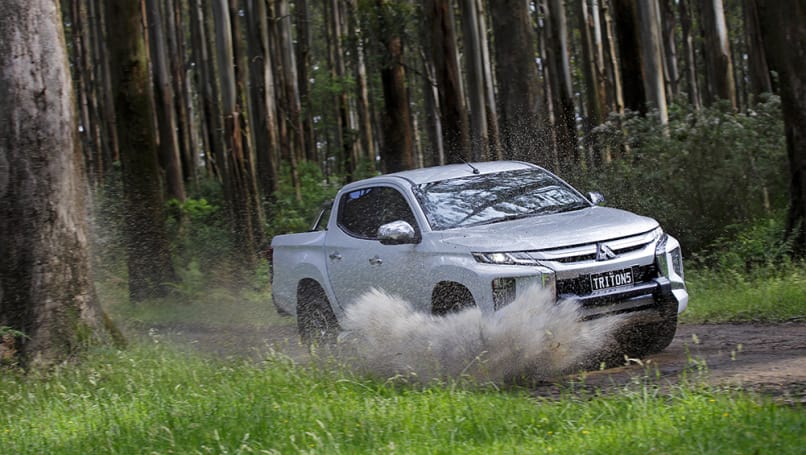
There haven't been any adjustments to the steering, and it reacts predictably. There's good weighting to it, both at city speeds (light, which helps negate the plenty of turns required to go lock-to-lock - but it has a smaller-than-average turning circle of 11.8m) and at pace, where you don't need to twist your arms as much but still get the exact responses you expect. Push too hard and you'll get the tyres to squeal, but it doesn't do too badly in the bendy stuff... for a ute.
The diesel engine hasn't seen any changes, but the transmission in the automatic models has added an extra gear. It makes for a more relaxed drive experience on the highway, as the revs aren't as high. Plus the way the gearing has been adjusted means that it feels a bit more zesty from a standing start - I mean, the 0-100 acceleration performance isn't astounding, but it's quick enough.
It is a bit noisy under hard acceleration, though the levels of quietness at higher speeds are definitely higher than the model that came before it, thanks to additional noise deadening. Shame the stereo is pretty poor, though.
Our off road review included testing the modes that have been added to the higher specs with the Super Select II system - snow/mud, gravel and sand in high range with the centre diff locked, with an additional rock mode in low range - definitely work well to help you get where you need. The transmission, throttle response, stability control and ABS are all tweaked.

We drove on dirt, gravel, mud, rocks and sand in all the modes. I got slightly stuck for a few seconds climbing a slippery rocky ascent while the vehicle was in 4H with the centre diff locked. Just a quick turn of the Super Select knob to 4L and a button press to engage rock mode, and it was off again. The traction control system was particularly impressive, allowing enough spin to attempt to keep momentum when grip was momentarily lacking.
The serious off-roader might want to consider a lift kit for even more ground clearance, and getting rid of those shiny new alloy wheels on the high-grade models for a set of smaller, wider rims with all terrain tyres. The mud wasn't that deep, but the wading depth of 500mm isn't as good as the best in class (Ford Ranger - 800mm).
There was no chance to do a towing review this time around.
Basic Warranty
5 years / 100,000 km warranty
ANCAP Safety Rating

The new benchmark for safety in the ute segment is the Mitsubishi Triton. I never thought I'd write that sentence, but the brand has nailed it when it comes to safety inclusions for this update.
As with many rivals, you need to opt for the highest grade model to get the best gear, but the fact remains that it outdoes all of its competitors for active safety equipment - yes, including the Mercedes X-Class and Ford Ranger.
GLX models are fitted with reversing sensors (on pick-up models), while GLX ADAS models add 'forward collision mitigation' - a forward collision monitor including auto emergency braking (AEB) that works at high and low speeds. Lane departure warning is standard on GLX ADAS models, too.
GLS and GLS Premium models add a few segment-first items, including blind spot monitor, rear cross traffic alert, and an ultrasonic misacceleration system that will dull throttle response if it thinks you'll hit something at low speed. There's also lane change assist, front parking sensors and auto high-beam headlights.
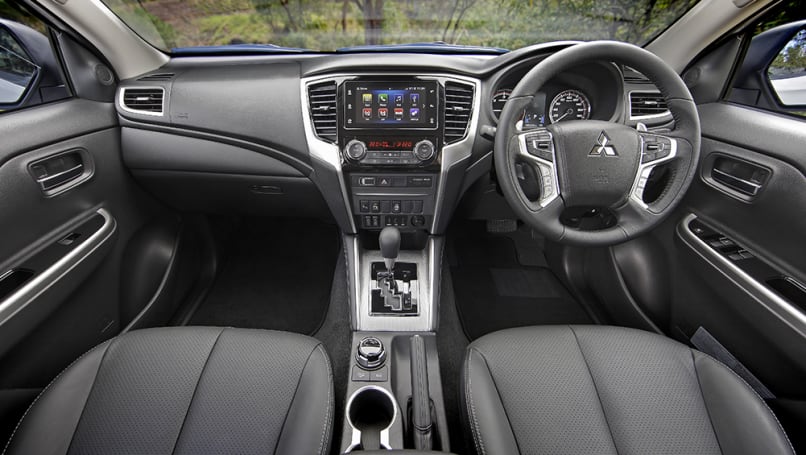
GLS Premium is the only model in the range to get the excellent and very handy Multi Around monitor, a 360 degree camera setup that offers a surround view display on the screen. The only thing that's missing is adaptive cruise control, which is available in the Ford Ranger... but still, that's arguably more a convenience feature than a safety highlight.
All variants get a reverse camera as standard - even cab chassis models, provided they're fitted with a Mitsubishi genuine tray.
Every model in the Triton range has seven airbags (dual front, front side, full-length curtain and driver's knee).
Dual cab models all have ISOFIX child seat anchor points in the outboard positions, and there are three top tether attachments for a baby seat (or three). Mitsubishi's 'Club Cab' models don't get ISOFIX or top tether points, and the single cab models have a passenger-side ISOFIX point but no top tethers.
The Mitsubishi Triton scored the maximum five-star ANCAP crash test safety rating under the 2015 testing regime, and the new model would presumably repeat the feat - though there is no plan for it to be retested, according to Mitsubishi.
The new Triton range is offered from launch until June 30 2019 with a seven-year/150,000km warranty. That warranty may be extended, or may revert to the brand's existing five-year/130,000km plan.
The company has a capped price servicing plan with maintenance requirements every 12 months or 15,000km. The schedule cost plan is exceptional cheap - the diesel costs just $299 per visit (yep, for the 30000 km and the 45000 km services it's the same), while petrol models are even less - $199 per visit ($597 = three years' cover).
The brand includes roadside assist as part of the ownership plan at no cost.
For information on common problems, issues, faults, reliability complaints - including specifics like suspension problems, automatic transmission problems, gearbox problems, recalls and more - see our Mitsubishi Triton problems page. Don't forget, there's always the owners manual for simple things like how to undo the spare tyre.
This is a facelift done right. The new-look Triton isn't just more attractive, it also offers a lot for customers to like - not least of which is the brand's unprecedented stance as safety leader in the ute segment. Kudos, Mitsubishi.
It may not be as polished as a Ranger, as gutsy as an Amarok, as classy as an X-Class, or as rugged as a HiLux - but the Triton now stands up as more than just a value-focused offering in the segment. The GLS is a terrific bang-for-your-buck offering, and stands out as our pick of the range.
The new Triton deserves to do very well.
Note: CarsGuide attended this event as a guest of the manufacturer, with travel and meals provided.
| Vehicle | Specs | Price* | |
|---|---|---|---|
| GLX | 2.4L, Diesel, 6 SP MAN | No recent listings | 2019 Mitsubishi Triton 2019 GLX Pricing and Specs |
| GLX (4X4) | 2.4L, Diesel, 6 SP MAN | No recent listings | 2019 Mitsubishi Triton 2019 GLX (4X4) Pricing and Specs |
| GLX Plus (4x4) | 2.4L, Diesel, 5 SP AUTO | No recent listings | 2019 Mitsubishi Triton 2019 GLX Plus (4x4) Pricing and Specs |
| GLS (4X4) Sports EDT | 2.4L, Diesel, 6 SP MAN | No recent listings | 2019 Mitsubishi Triton 2019 GLS (4X4) Sports EDT Pricing and Specs |
| Design | 9 |
|---|---|
| Practicality | 8 |
| Price and features | 9 |
| Under the bonnet | 7 |
| Efficiency | 6 |
| Driving | 7 |
| Safety | 10 |
| Ownership | 8 |
$14,999
Lowest price, based on 579 car listings in the last 6 months